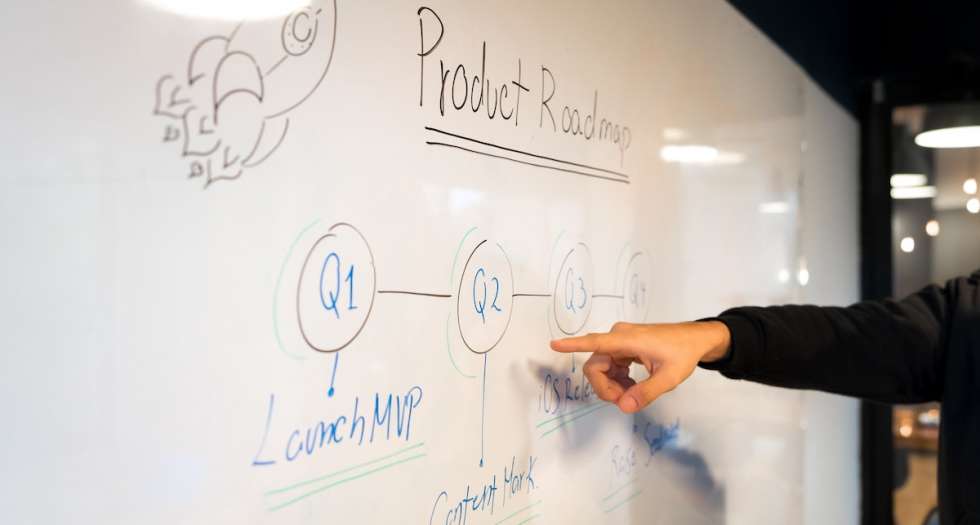Whether you’re an early-stage startup or an established business, a product development roadmap is at the heart of innovation and success. However, in a rush to build a Minimum Viable Product (MVP), sometimes startups skip this part of the process with dire consequences.
But before we get ahead of ourselves, let’s define it.
What’s a product development roadmap?
A product roadmap forms the foundation fo your startup product development strategy. Before embarking on an application development project, roadmaps demand that all aspects of the project, even the minor ones, are first “mapped out” on paper.
Often, these roadmaps visualise what needs to be accomplished in Gantt-chart style diagrams. When you have a well thought out roadmap, your business is well-placed to create a development budget, the direction of the development project, set up protocols to track progress, and more. For startups, the roadmap will also include the product’s mission, vision, and features.
The roadmap, essentially a startup product strategy, also has a timeline for each team member’s task and the overall project. The end goal here is to get all stakeholders aligned on what is being developed and why.
The software or application roadmap works as a guide that provides supervision and leadership on how the team will innovate and develop over time and how the product fulfils the target audience’s demands.
This document that usually embraces the agile framework promotes the “vision” to business leaders, designers, developers, programmers, project managers, and marketers.
Why it’s critical for startups to create product roadmaps?
While it might seem like a “waste of time” for the inexperienced, a product roadmap helps companies develop a robust software development strategy to meet short-term and long-term goals.
After all, early-stage startups are essentially “fragile entities” that find their way and place in the grand scheme of things. So a software strategy is critical to achieving your objectives.
Without a product development roadmap, for example, the team can quickly lose focus and work on exciting new features that aren’t demanded by the target audience. When everyone is on the same page working towards a common goal, it accelerates time to market and saves time.
Other benefits of creating a robust startup product development strategy or roadmap:
- It helps set and maintain a strategic focus
- It helps keep the team motivated
- It helps postpone some technical hires (saving money)
- It helps product owners plan and prioritise things
- It provides strategic direction
- It provides visibility to all stakeholders
What should your bespoke software development roadmap look like?
Whether your startup is engaging in custom application development or bespoke software development, your roadmap should only include what’s necessary. For example, you can leave most of the team’s ideas out of it and focus on what needs to be accomplished to arrive at an MVP.
You can save all team ideas, especially the exciting ones, for another document (that you can revert to later). Your product development roadmap should only contain shorter-term strategic plans and functionality needed for an MVP or the highest ROI features.
Your roadmap that features diagrams and charts doesn’t have to be pretty. In fact, it doesn’t need to be in digital form (although it helps to have one).
But once your product and company scale, you might want to invest in a purpose-built roadmap tool that’s incorporated with project management tools. But for now, all that matters is what’s in it, not the presentation.
There are three primary phases that lead to a successful roadmap:
- Market research
- Product documentation
- Project timeline
Market research
Regardless of whether you’re entering an existing market or creating a new market for your digital product, your target audience is key to your research. Define the target audience and market, define your objectives, and thoroughly research it to ensure that there’s a (real-world) market for your idea.
Some of the tasks included in market research are as follows:
- Define the goal of your research
- Create a product pitch
- Define your mission and vision for the product (and the startup)
- Engage in market research
- Research your competitors
- Outline the pros and cons of embarking on the project
- List the tools demanded by the product development environment
- Leverage an issue management tool and track your product’s evolution
- Brainstorm with all stakeholders
- Survey the target audience
- Discuss results
The findings dictate your project goals, the skills and technologies needed to achieve them, and your startup product strategy. By brainstorming with the team, product owners and project managers are better placed to validate the idea and develop a consensus among all team members (and stakeholders).
Discussions and regular brainstorming sessions are vital to ideate, validate, and build successful digital products.
Product documentation
The project manager is charged with developing the product documentation. This document is often driven by the Agile framework and User Experience (UX).
During the product documentation phase, you’ll have to accomplish the following:
- Choose a platform for your product
- Create drawings and printable mockups
- Complete UX research (but only if your budget allows it)
- Define the product’s features
- Develop a flowchart of various product and user flows
- Use tools (like Adobe XD or Balsamiq) to build mockup for the main features
- Set the limitations for the features
- Decide on an MVP
Keep your ideas for functions and features that are planned for a later date, separate. This approach ensures that the team focuses on the task at hand.

Project timeline
Decide on the project’s timeline after reviewing all the tasks that must be accomplished with the whole team. By discussing the project with the development team, you’ll be better placed to formulate a reasonably accurate timeline and product roadmap.
At this juncture, factor in unforeseen problems, delays, and estimate the margin of error for the deadlines by considering the edge cases. In fact,
research suggests that as much as 85% of software projects run over schedule.
So development teams must adapt and restructure the plan during the development cycle.
How do you define your product development lifecycle?
While there are many approaches to defining the product development lifecycle, there are seven key stages to pay attention to:
- The gathering and analysis of project requirements
- Planning
- Design
- Programming and implementation
- Testing (and more testing)
- Deployment
- Maintenance and improvement
How do you set a precise measurement for success?
No software development strategy is complete without measurement protocols. But how do you go about it? If the product goes live on schedule, is the project deemed to be successful?
The short answer is, “it depends.”
What’s considered to be a successful software product depends on individual startup goals. In this scenario, start by measuring everything that has a direct impact on your objectives. These metrics are monitored continuously and awards the opportunity to make incremental improvements.
The following are some metrics technology startups are known to measure:
- Agile process metrics (like the lead time, cycle time, team velocity, and open/close rates)
- Production analytics (like the mean time between failures, the mean time to recover/repair, and the application crash rate)
- Security metrics (like endpoint incidents and the mean time to repair)
- Source code metrics (to accurately estimate the testing efforts)
Put together, the metrics above shed some light on whether or not you’re achieving your objectives. However, it’s crucial to note that these metrics should only test hypotheses and answer questions about specific project goals.
Furthermore, it should only be done if the questions and answers help drive positive change. Finally, each feature should have its own success metric directly related to the value delivered to the end-user.
In conclusion, startups must leverage product development roadmap before writing a single line of code. This approach ensures that you’re building a digital product that is not only viable but also timely and cost-effective.
To learn more about the benefits of leveraging product roadmaps, schedule a commitment-free consultation.

